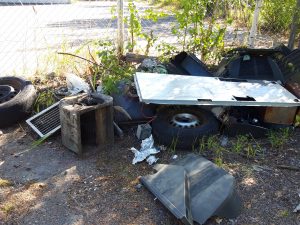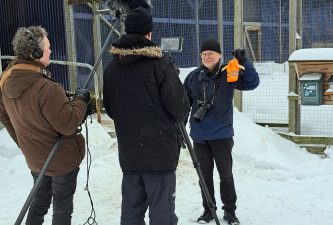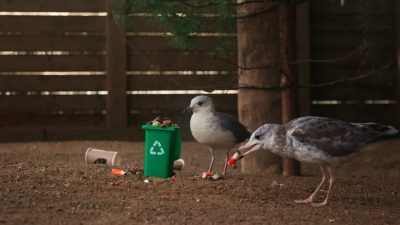What Helsinki is doing
Helsinki is tackling littering in many ways. The City implements and enforces the Waste Act and the Environmental Protection Act, participates in several environmental protection programmes and coordinates volunteer work.
On this page
- News
- What is Helsinki doing to control litter?
- Locations of waste bins on a map
- Examples of the City’s measures to prevent littering
- Litter control is part of the Helsinki City Strategy
- Cooperation in Finland and internationally
What is Helsinki doing to control litter?
Helsinki has been tackling the problem of littering for a long time using various methods. In addition to coordinating voluntary work, Helsinki is a partner in several different projects and programmes aimed at seeking ways to prevent littering and raise awareness of it. These include the Baltic Sea challenge, Mahanpuruja muovista and BaltiPlast. The City also implements and enforces the Waste Act and the Environmental Protection Act.
The party responsible for waste management in Helsinki is HSY
Effective waste management is one of the most important ways to reduce littering. The biggest sources of litter in the city include different types of packaging and disposable products, and the best ways to prevent them from ending up in the environment is effective waste management. Waste management includes the collection, transport, recovery and disposal of waste generated by properties, such as schools, daycare centres and residential buildings.
Helsinki Region Environmental Services (HSY) is responsible for municipal waste management in the Helsinki Metropolitan Area and Kirkkonummi. Provisions on municipal waste management are laid down in the Waste Act (646/2011) and the Waste Decree (978/2021). Waste legislation also includes provisions on the sanctions for littering and cleaning responsibilities.
Finland’s waste legislation was reformed in 2021. As part of the reform, Finland set a target of having 65% of municipal waste processed for recycling or reuse by 2035.
The city of Helsinki is responsible for waste bins in public areas
The City is responsible for emptying nearly 8,000 waste bins dotted around Helsinki. The emptying frequency of these waste bins depends on the maintenance class of the area in which they are located.
The inner city of Helsinki is a maintenance class 1 area, where waste bins are emptied every day. The party responsible for emptying waste bins located in public areas is the City, while property owners are responsible for emptying waste bins located on the pavement, and at bus and tram stops within the inner city area.
There are 2,510 waste bins in the green areas and 1,291 waste bins in the street areas of inner city Helsinki.
Helsinki’s suburbs belong to maintenance class 2: they have fewer waste bins than the inner city area and the waste bins are also emptied less frequently. There are 2,610 waste bins in the green areas and 1,696 waste bins in the street areas of Helsinki’s suburbs that are maintained by the City.
Helsinki’s forest areas are not subject to regular cleaning. Forests are mainly cleaned when an acute need for cleaning arises (due to unauthorised landfills or other waste deposited in forests) or as part of litter picks organised by volunteer residents.
Locations of waste bins on a map
The City is responsible for emptying nearly 8,000 waste bins dotted around Helsinki.
The City is responsible for environmental monitoring and supervision
The City of Helsinki’s Environmental Monitoring and Supervision Unit performs the supervisory tasks assigned to municipal environmental protection authorities by the Environmental Protection Act and the Waste Act, among other regulations.
In 2023, the City processed 80 hazard reports related to waste. The majority of these hazard reports concerned littering. In reality, the number of littering incidents is much higher: because it is often not possible to determine the litterer, most littering incidents remain unresolved or are never processed. In these cases, the City cleans its own areas under the secondary obligation to clean up imposed by the Waste Act.
Examples of the supervision carried out by the City:
- Helsinki monitors the suitability of gritting sand for reuse. Cigarette butts thrown on the ground make gritting sand more difficult to reuse because they are difficult to remove from the sand. As such, cigarette butts can hinder or even completely prevent the reuse of gritting sand, in which case the sand must be disposed of as waste.
- The City of Helsinki’s Building Control Services monitor the largest building projects in Helsinki during their construction phase. The City will intervene when necessary if a waste collection point is not kept clean or waste spreads into the environment.
- Mobile kiosks also sometimes cause littering. For example, operators may pour cooking fat directly into storm drains near the kiosks. The operations of mobile kiosks are monitored by environmental inspectors.
Examples of the City’s measures to prevent littering
Helsinki’s maritime cleaning season, during which the boats of Helsinki City Construction Services Stara collect waste from the sea on a daily basis, starts in the spring. During the season, Stara’s boats can be spotted in the Market Square harbour area, for example.
The aim of the boats is to keep Helsinki’s coastal waters as clean as possible. In 2023, they collected just under 100 cubic metres of waste from the Helsinki Metropolitan Area’s waters. The boat team is also responsible for waste management in the archipelago. During the summer season, the boats are also tasked with scanning the sea floor, collecting water samples and cleaning the areas around the Ruoholahti canal, unsupervised public beaches and fishing piers with the help of divers.
Stara’s Sea and Archipelago Services and Nature Services units operate a total of seven boats. The operating period of the cleaning boats starts in mid-April and ends in mid-November.
Many artificial turf fields in Helsinki still use crumb rubber as an infill material, which releases rubber into the environment and stormwater. Less than half of these fields are managed by the City.
The City of Helsinki has started to implement measures to better prevent the release of crumb rubber into the environment: some fields have been outfitted with elements that prevent the crumb rubber from being released into the environment, such as fence barriers, stormwater well filters and snow clearing areas.
In future renovations of sports parks, crumb rubber will be replaced with organic infill materials. In 2023, Helsinki replaced artificial turfs at six locations in Kontula, Kallahti, Vuosaari, Kivikko, Jakomäki and Laajasuo. With one exception, all of these new artificial turfs now have plant-based infill materials instead of crumb rubber. Plant-based infill materials do not contain microplastics or other substances that are harmful to the environment.
The environmental impact of construction has been identified in Helsinki. This is significant, as construction is one of the key themes in the most important environmental protection action programme measures of the City. Wind and water carry construction debris, such as packaging materials, pieces of expanded polystyrene and lead-in lines, away from construction sites.
In order to prevent and mitigate the adverse environmental impact of construction projects, land use planning always performs a project-specific review and assessment of environmental effects. Those embarking on a construction project must ensure that a separate construction site water management plan is also drafted for the project. This applies to both infrastructure and house building projects.
The City of Helsinki complies with the construction site water management guidelines (työmaavesiohje) issued by the Helsinki metropolitan area environmental protection authorities and Helsinki Region Environmental Services Authority (HSY) on its construction sites.
All construction sites must aim at minimising their wastewater and making the water quality correspond with natural water when water is discharged into the environment. No substances harmful to the environment may enter the environment with construction site water. Littering must also be prevented.
One of the focus areas of the City of Helsinki’s Action Plan for the Circular and Sharing Economy updated in 2023 is construction. The measures in the action plan address the environmental impact of land use planning, infrastructure and green construction as well as demolition. The plan also aims at accelerating circular economy in City of Helsinki purchases, for example.
The Litter-free Helsinki campaign started in spring 2024 offers comprehensive information on littering in Helsinki and highlights the cost of littering.
Communications are carried out in various projects that Helsinki is involved in, such as the Baltic Sea challenge and BaltiPlast. In the annual Stomach Ache from Plastic campaign, the City of Helsinki communicates the harmfulness of trash ending up in rainwater gullies together with the Keep the Archipelago Tidy organisation. Other communications campaigns over the years have included Helli Helsinkiä (Be kind to Helsinki) and Puhuva roskis (talking rubbish bins).
The City Of Helsinki also provides free-of-charge environmental education activities and materials to daycare centres, schools and residents.
The Harakka Nature Centre provides children and young people with information on the Baltic Sea and littering, archipelago nature and sustainable lifestyles. Together with the Finnish Environment Institute, the City Of Helsinki has produced the Roskapolku (Litter Trail) material for school groups and clubs. The Litter Trail is a checkpoint route about the impacts of litter on nature. The objective of the material is to highlight how everyday objects become harmful to organisms if they end up in nature.
Litter control is part of the Helsinki City Strategy
Litter control has been taken into account in the City’s strategies and programmes. During the 2021–25 strategy period, the City will be focusing particularly on ensuring that preconditions for a pleasant city, such as the cleanliness of parks and streets, are taken into account throughout Helsinki. Helsinki is also involved in several cooperation projects aimed at reducing littering in Finland and internationally.
Litter Control Action Plan
In 2019, Helsinki signed the Plastic Declaration and agreed to develop strategies and action plans and set targets with deadlines for significantly reducing plastic litter. In 2020, Helsinki launched the Litter Control Action Plan.
The aim of the Litter Control Action Plan is to gather the best ideas for practical measures to reduce litter, tackle the growing problem of litter and the damage it causes to the environment and health, raise awareness and knowledge of the problem of litter and guide efforts towards reducing litter.
The Litter Control Action Plan consists of a programme of measures and a network bringing together those working on litter. The programme is valid from 2022 to 2025, and will be updated when the next council term begins in 2026.
Many measures to curb litter require long-term and continuous action. On the other hand, some of the measures are shorter-term pilots to test new innovations and thus support new business. Many of the measures also require cooperation with different operators and stakeholders.
The litter control steering group will meet twice a year to monitor progress in implementing the action plan. At the end of the programme period, the implementation and effectiveness of the programme will be reported to the Urban Environment Committee.
Litter Control Action Plan 2022–2025
Cooperation in Finland and internationally
In Finland, the national implementation of the EU Single-Use Plastics (SUP) Directive was carried out through amendments to the Waste Act and associated regulations that entered into force at the beginning of 2023. The Directive is aimed at reducing plastic pollution in the environment, especially on seashores, promoting a circular economy and harmonising product regulation in the EU internal market.
The City of Helsinki is implementing the SUP Directive in two different EU-funded projects: BaltiPlast and PlastLife. The aim of these projects is to reduce plastic and plastic litter in Helsinki.
BaltiPlast
The City of Helsinki is involved in the Interreg EU project BaltiPlast. The objective of the project is to reduce unnecessary plastic use in the City’s own activities, companies and households. In addition to this, the project will determine the largest sources of plastic litter in the city. To these ends, the project involves piloting strategic measures and new innovations. The aim is to integrate solutions and tools that prove effective into the Litter Control Action Plan when it is updated in 2026.
PlastLife
PlastLIFE is an extensive national cooperation project to promote the circular economy of plastics. The goal is a sustainable circular economy for plastics in Finland by 2035.
Other cooperation
Closed Plastic Circle
Helsinki is involved in the Closed Plastic Circle project, the aim of which is to facilitate the efficient recycling of all recyclable plastic. Under the guidance of the Ministry of the Environment, Finland has drawn up the Plastics Roadmap for Finland (Ministry of the Environment 2018), which includes proposed measures for addressing challenges associated with plastics.
Read more about Closed Plastic Circle (in Finnish)
Plastic Smart Cities
Plastic Smart Cities is an international movement launched by the WWF, which is committed to stopping the leakage of plastic waste into the environment and into the sea. Helsinki is the first Plastic Smart Cities partner city in the Baltic Sea region.


